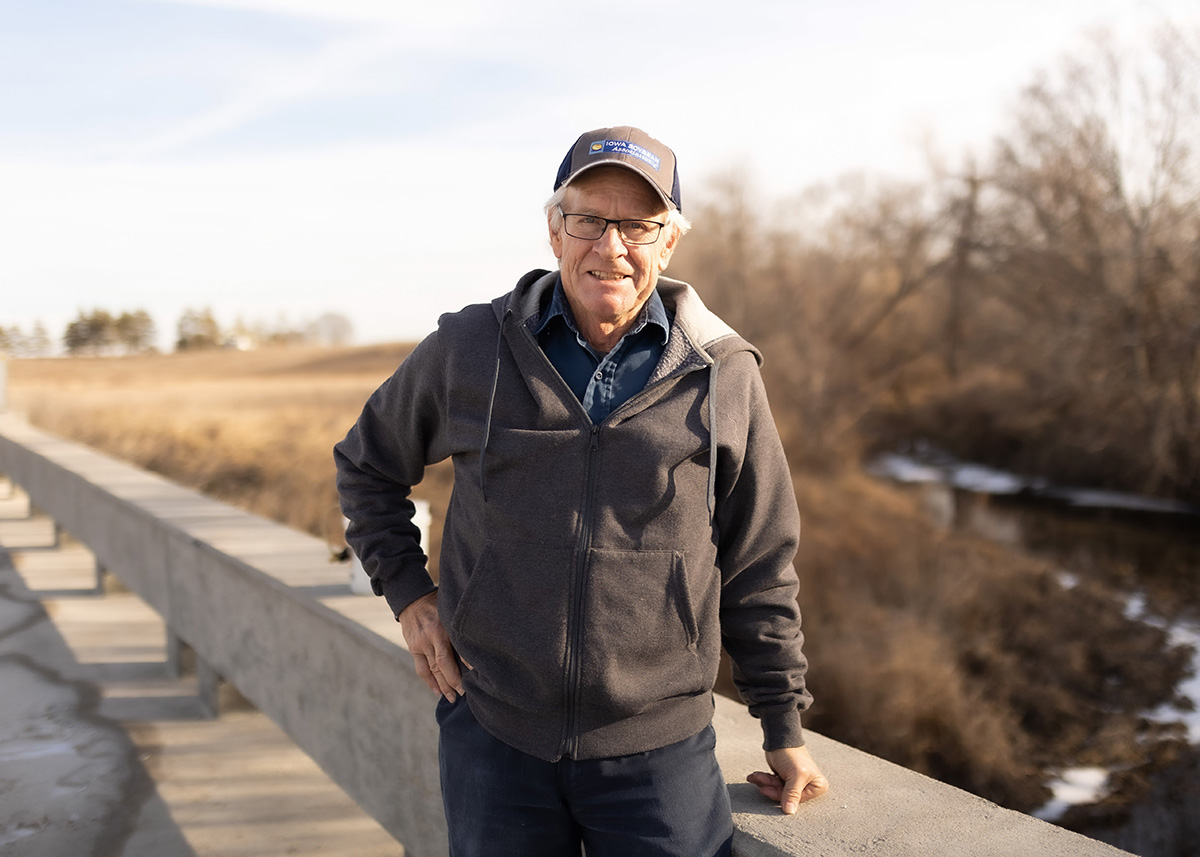
Craig Fleishman, ISA farmer-member in Minburn, relies on the Iowa Soybean Association to monitor water quality leaving his farm (Photo: Joclyn Bushman/Iowa Soybean Association)
ISA water lab provides data to help improve water quality
January 18, 2022 | Kriss Nelson
The Iowa Soybean Association’s (ISA) water lab will soon complete its 11th year of water monitoring.
The facility is a unique asset, connecting directly with the work of the Research Center for Farming Innovation (RCFI).
“We are in the business of helping our farmers be productive, profitable and sustainable,” says Roger Wolf, RCFI director. “We work to bring data and research results to the table, and this information gives a certain amount of credibility to our work.”
Located on-site at ISA, staff at the water lab first began testing water samples in 2011. Previously, water sample analysis was done in partnership with the Des Moines Water Works lab. During that time, monitoring was done on stream samples, and tile sampling started once ISA had its own lab.
“The water lab gives us the capacity to commit to water monitoring by having it on-site compared to having to work with a private lab or a third party,” says Tony Seeman, senior field services lab and data manager at ISA. “We work with projects to help farmers use data to know where to target resources to treat the highest levels.”

Tony Seeman, Sr. Field Services Lab and Data Manager at ISA
Water testing
The ISA water lab will test thousands of samples each year. The accredited lab is certified by the U.S. Environmental Protection Agency (EPA) through the Iowa Department of Natural Resources to analyze E. coli bacteria, nitrates, nitrites and fluoride under the Safe Drinking Water Act.
Ion chromatography is used to test common nutrients including nitrates, nitrites and phosphate as well as fluoride, chloride and sulfate.
Other tests conducted in the lab include turbidity (a measure of water clarity), total phosphorus, alkalinity and hardness, and ammonia nitrogen.
In 2021, the lab analyzed more than 4,100 individual samples as part of 20 different projects. Dry weather conditions prevented the collection and analysis of an additional 1,300 scheduled samples. Projects ranged from the traditional Agriculture’s Clean Water Alliance (ACWA) tributary sampling of the Raccoon and Boone Rivers to supporting multiple Iowa Department of Agriculture and Land Stewardship (IDALS) Water Quality Initiative demonstration projects.
New projects for 2021 included a series of sampling events throughout Lyon County with the local Soil and Water Conservation District and providing sample analysis to support the Soil and Water Outcomes Fund verification efforts.
The data has been compiled and reports will be generated for the projects. They will be sent to more than 150 participating farmers, detailing the data and comparing results to other sites statewide.
Craig Fleishman, an ISA farmer member from Minburn, has been participating in water monitoring for several years. He’s grateful ISA has taken the initiative to be proactive about water quality.
“As a farmer, I am interested in seeing what the tile lines are carrying and where it ends up,” Fleishman says.
Fleishman says results from his water samples reinforce why he uses conservation systems on his farm. He gathers samples from tile lines, creeks and rivers every two weeks and encourages others to do the same.
“If anyone is interested, they should try it,” he says. “Every producer has some creek or tile line to test. It’s easy to do.”
Water monitoring plays a significant role in achieving goals set by the Iowa Nutrient Reduction Strategy.
“We need a 45% reduction of nitrates from every acre in Iowa,” Seeman says. “You need to know where you are at to determine next steps in achieving the 45% reduction per acre.”

Results of water monitoring
Water monitoring allows farmers to better understand the conditions in streams and water leaving the farm property, whether via surface flow or tile water. This often leads to more questions about what can be done to protect or improve water quality.
Monitoring several locations over many years enables RCFI to focus programs and topics specific to issues that are present. Wolf says many watershed projects receive additional funding support to address specific concerns local farmers are trying to remedy.
Having monitoring capabilities creates opportunities to validate actual changes in water quality derived from the performance of using management techniques, products and practices.
Looking ahead
Like soil testing, farmers value having water quality data, and ISA intends to keep supplying the information.
Wolf says the long-term vision for the laboratory is to continue embedding monitoring as part of our comprehensive research at RCFI. “Monitoring helps farmers and partners focus programming and validate the performance of in-field and edge-of-field strategies,” he says. It gives farmers confidence their practices are performing, which drives continuous improvement for the sustainable production of soybeans.”
Increased demand for these services could lead to an expansion of the ISA water lab.
“Over the next 10 years, we hope to find ways to lower the cost and speed up access to actionable information to help farmers make informed decisions accurately and faster,” Wolf says. “New sensors, expanded analytics and data decision tools are likely.”
Back